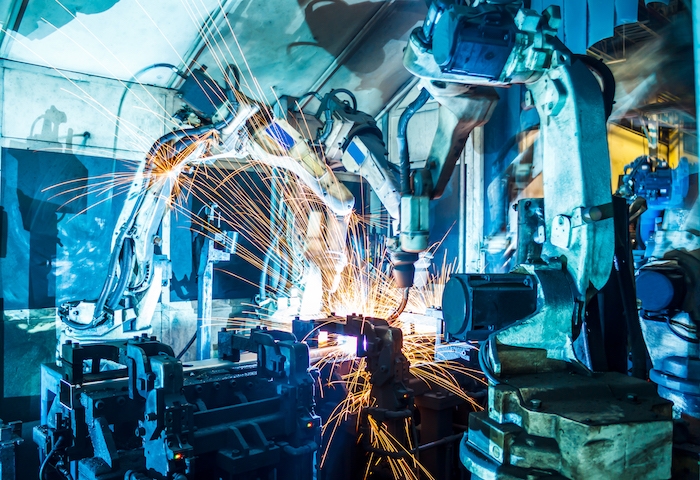
North America increases automation on the road to the future factory
August 5, 2019
By Kristina Urquhart
 Photo: PJ66431470/iStock/Getty Images Plus
Photo: PJ66431470/iStock/Getty Images Plus August 5, 2019 – Over in Europe, the future factory is quickly moving past a concept and into reality.
Manufacturers are embracing large-scale automation, human-robot collaboration and connectivity to push Industry 4.0 forward. For example, at Hannover Messe 2019, sensor manufacturer SICK shared footage of the flexible manufacturing cells at its new Industry 4.0 factory in Germany, and Nokia showed its Factory in a Box service, which brings Industry 4.0 solutions (including robotics, additive manufacturing and virtual reality) directly to manufacturers to be brought online in a number of hours.
And a new report by the Robotic Industries Association (RIA), a U.S.-based trade group, reveals that robots were shipped in record numbers to North American companies in 2018. A total of 35,880 units were shipped, a seven per cent increase over 2017. Proof of the ripple effect: more nonautomotive manufacturers are installing robots than ever before, with numbers up 41 per cent.
Orders from food and beverage and consumer goods manufacturers were up 48 per cent in 2018, with increases also recorded in plastics and rubber (37 per cent), life sciences (31 per cent) and electronics (22 per cent).
“While the automotive industry has always led the way in implementing robotics here in North America, we are quite pleased to see other industries continuing to realize the benefits of automation,” says Jeff Burnstein, president of the Association for Advancing Automation (A3), of which RIA is a member, in a release. “And as we’ve heard from our members and at shows such as Automate, these sales and shipments aren’t just to large, multinational companies anymore. Small and medium-sized companies are using robots to solve real-world challenges, which is helping them be more competitive on a global scale.”
So North America has the automation, or is at least implementing more of it. What’s next on the road to the future factory? It all comes back to connectivity – for example, through sensors and other Internet of Things–enabled devices, network architectures and data transmission.
In a recent report called “The Future of Automation: Key Enabler for the Vision of Future Factories,” research firm Frost & Sullivan has identified three trends facilitated by connectivity that are impacting automation.
1. Artificial intelligence (AI): AI is assisting traditional engineering models in becoming automated systems. It allows for continuous operational learning and potential productivity gains that go beyond what humans can do.
2. Edge computing: Computation at the local device can expand PLC functionalities with more computing power and personalized operational needs without impacting overall production architecture. Select data can be delivered to the cloud for further analysis, storage and access.
3. Augmented reality (AR): Frost & Sullivan sees AR as the HMI of the future, enabling operators with high transparency and insights into controllers, machines and production processes. It allows for remote collaboration between machine experts, plant manufacturers, service technicians and maintenance personnel.
“Innovation has played out, but fundamental designs have not witnessed a major overhaul,” says Karthik Sundaram, industrial IoT programme manager at Frost & Sullivan. “However, the automation of yesteryear is slowly becoming untenable for realizing future needs. This requires reimagining automation across all facets, starting from design, engineering, deployment and operation.
“Envisioning the future of factories must first begin with a vision for the future of automation, an approach that has been relatively less explored in the industry today.”
_____
This article was originally published in the Summer 2019 issue of Robotics Insider, Manufacturing AUTOMATION’s quarterly e-book focused on robotics.
Advertisement
- OnRobot opens first R&D office in North America
- Are you ready for the WSIB’s new premium rate model?